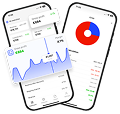Skyrocketing e-commerce
The idea for ProfitMetrics.io came about, when I owned an extremely fastgrowing online store in 2015. Within less than 1 1/2 year, I had 10 employees and a double-digit million turnover. We sent newsletter daily to more than 200.000 Danes and advertised heavily on Google, Facebook and television.
My focus was on turnover growth and finding new products and categories. As administrative work increased e.g. accounting and employments, it was necessary to hire an administrative assistant.
In short time, he discovered that certain things did not add up with the financial statements. I'd worked with an accountant, who was a person whom I've known since childhood and naturally trusted. Sadly, this turned out to be a bad idea. The administrative worked and I discovered that the accountant had not made any bank reconciliations for more than a year and the accounting was messy. This breach in confidence lead us to hire a new accountant, who started over on the bookkeeping.
Facebook was impressed
Meanwhile, the growth continued. Back then, Facebook was not seen as a sales platform and in fact it was frowned upon to do it. But I'd cracked the code and we had great positive ROAS results on the turnover from Facebook. The numbers were so good that I got contacted by Facebook and was invited to their office in Ireland for their first Danish event. Here I made the first case study with a scandinavian e-commerce business. Naturally, Facebook wanted to make other business aware that it was possible to move goods directly via Facebook ads.
Facebook was in fact our largest paid traffic source and I was positioned almost as a "daytrader". I spent 10.000-15.000 DKK per day in Ad spend. But my performance measurements were not correct, even though I had high ROAS numbers. I'd missed a very important "detail".
I missed an important detail
My approach was to apply an average of the return on turnover from online advertising to suggest if it was profitable or not. This the method almost every ecommerce owner and marketing agencies are still using.
However, I hadn't considered the fact that often products were added to the order, which had a lower margin. For instance expensive high-branded products. Furthermore, we sometimes had free shipping and discount codes. This combination of events resulted in a considerably lower return than my usual average, which I'd used for my ROAS metric. As a consequence, I was in fact scaling unprofitable ads
So despite the apparent success, the interest from Facebook and the "best-practice" method I was using, I did not have my profits under control.
Deficit despite huge turnover and great ROAS results
In parallel to all of my "success" the new accountant was done and had the new numbers ready. I was chocked to learn that we were actually running a deficit on DKK 500,000. It's hard to imagine how this could be the truth, when the old accountant had presented profitable numbers. How can one be that wrong? Well, with a high turnover and money going in and out all day long, it was quite the challenge to see through the numbers.
As soon as the deficit was discovered, I initiated a rescue plan to figure out where to cut costs and where our money was made. Our ad spend was huge, so that is where I started my search. It was there I learned that I was optimizing based on the wrong average margin.
A part of the rescue plan was to lay off some of my great employees, which is one of the hardest things I've ever had to do. After a period of hard work and attempts to rescue the the business I was forced to acknowledge it was too late. My recovery plan was not enough. The business was bankrupt and all of my employees (including close friends) lost their jobs.
Despite the defeat, I refused to give in. I knew there was basis for a healthy business and a loyal customer base. So I found an investor and started it all over. It was a long and hard journey to create a profitable business, but I learned from my mistakes and turned it into a success.
The solution became til ProfitMetrics.io
I started to realize that I was not alone in making these mistakes. It was not uncommon to wait for the quarterly reports to have the financial overview. Neither was it rare to have shop owners use the average margin to measure campaign performance. Basically all ecommerce businesses had the same challenges.
This is what started my thoughts on what would turn into ProfitMetrics.io. How could one make a tool, which showed the exact profit per ad; remove guesswork and create transparency in all ads? How could one make a complete overview of gross and net profit after fixed costs and ad spend - in real time?
The solution was ProfitMetrics.io and I want to share my experiences with everyone - both the good and the bad. I hope to stop other ecommerce owners make the same mistakes that I made. Through the use of ProfitMetrics.io, ecommerce owners gain transparency in the ad spend. They can stop unprofitable ads, and move the budget to the ads that make them real profit. ProfitMetrics.io is created to make complicated questions simple. It's simply a matter of making rational choices based on actual profit - be it on a hourly, daily, weekly, monthly or yearly basis.
I want you all to react in time and secure your businesses.
ProfitMetrics.io made it possible for me to turn the bankruptcy into a highly successful exit in 2019.











